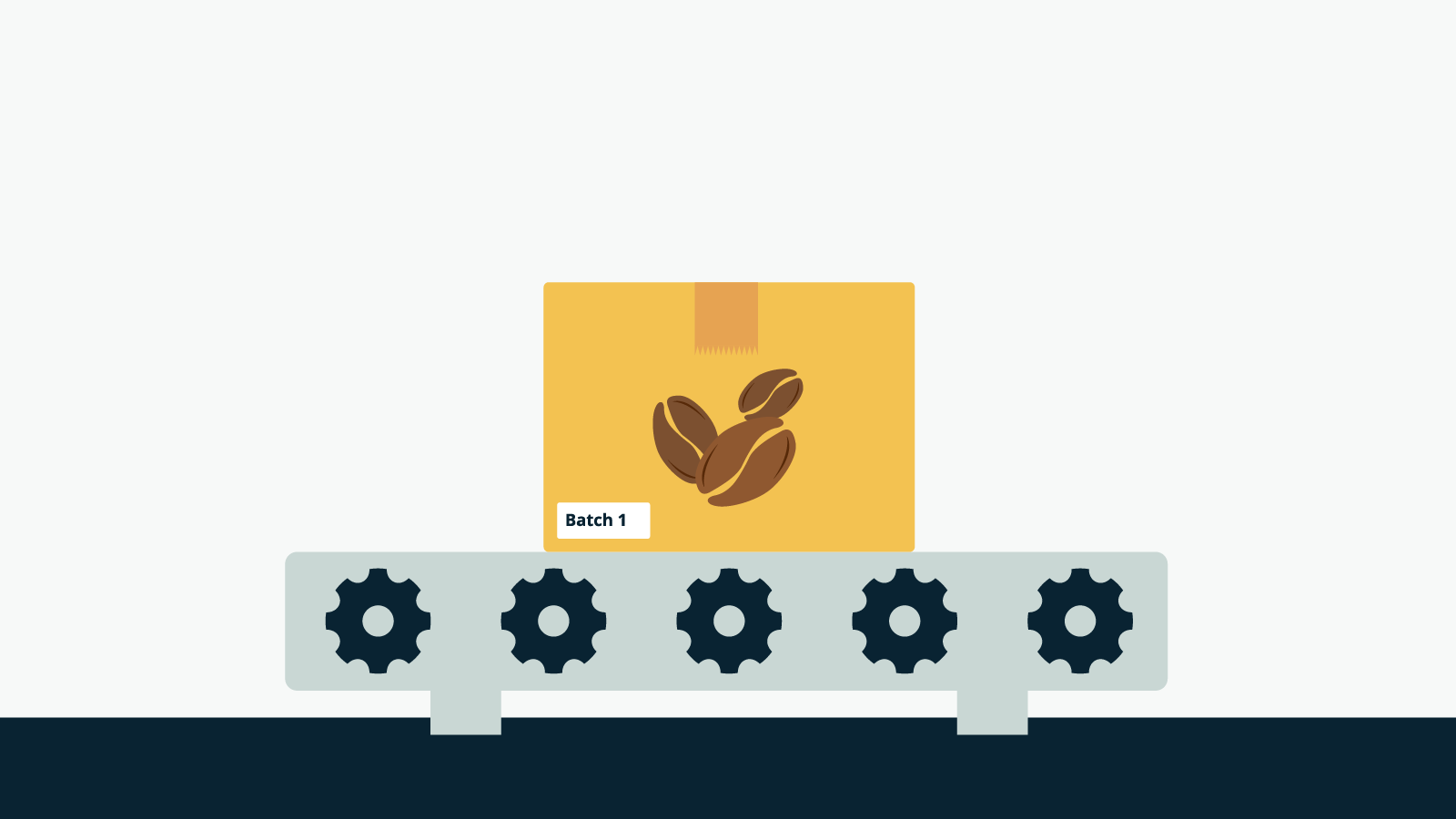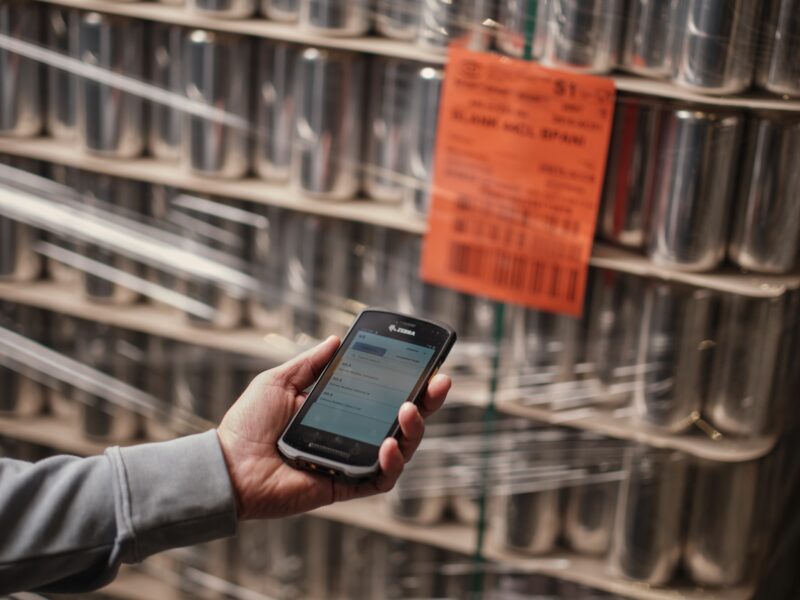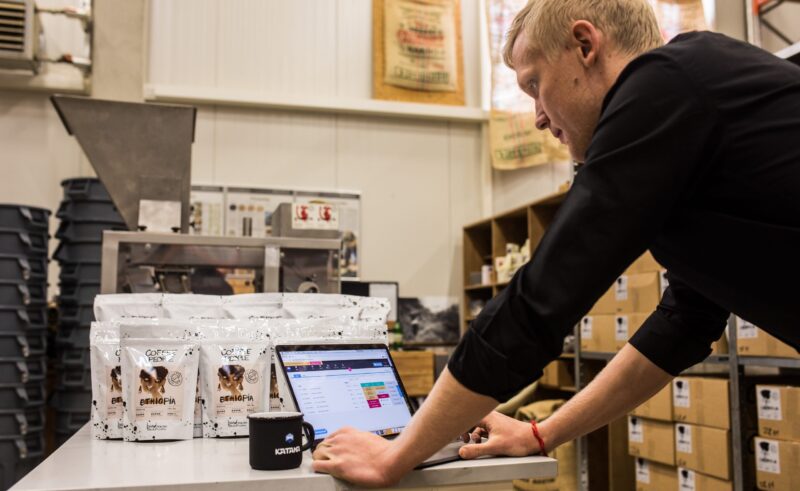Eat food, not profits — with food industry inventory management
Say goodbye to spoilage. From this article, you’ll learn how to optimize food industry inventory management as we share the ultimate tools and tips for optimizing this process.

James Humphreys

“As one bad apple spoils the others,” Benjamin Franklin was the first person to use this metaphor.
And although it applies to the observation of how one thing can corrupt another, it too applies to businesses handling food goods. One literal bad apple can spoil the literal barrel. If your livelihood depends on apples to make your apple pies, it doesn’t take much imagination to realize how this scenario isn’t good for you.
So, how do you ensure that your perishable inventory stays fresh?
Introducing food industry inventory management.
In this article, you’ll learn all about proper inventory management in the food industry, tips for improving it, why it’s important, and the best tools for the job.
What is food industry inventory management?

Food industry inventory management involves overseeing the supply, storage, and accessibility of ingredients and products within the food sector. This process ensures optimal stock levels, reduces waste, and improves efficiency, critical for meeting consumer demand and maintaining freshness.
Inventory management for food industry includes:
- Ordering produce, ingredients, and products
- Receiving those items
- Storing the goods according to industry regulations
- Distributing food to retailers and customers
An important part of inventory management in the food industry is storing food items properly. This includes tracking expiration dates and using proper storage methods to ensure that products don’t spoil or become contaminated. Additionally, businesses should regularly check their inventory to ensure they have enough supplies on hand to meet planned demand.
There are two types of food industry inventory management systems: manual and automated.
Manual systems typically involve paper records like inefficient spreadsheets and manual stocktaking, while automated systems like food inventory management software use computer solutions to track and manage stock levels. Automated systems provide businesses with real-time data on inventory levels, helping them make more informed decisions about ordering and stocking food items.
Effective inventory management processes in the food industry are essential.
To run a profitable food business, businesses need to monitor their stock levels, minimize waste, and ensure that products are fresh and safe for consumption. Additionally, proper storage methods and regular inventory checks can help avoid problems like food spoilage or contamination. All the features in automated systems are designed to help businesses improve overall efficiency and accuracy in their food inventory management.
What is food industry inventory management software?
A food inventory management system helps food businesses keep track of their stock levels, orders, and sales.
It can monitor trends and optimize order sizes to reduce waste and save money.
These solutions can be used by restaurants, grocery stores, caterers, and other food-related businesses. They offer many different features, but all share the same goal — helping food businesses run more efficiently. Some common features of food industry inventory management software include:
- Monitoring stock levels and sales data
- Generate reports on trends and inventory levels
- Setting up reorder point alerts for when stock levels are low
- Processing orders
- Tracking supplier information
Food industry inventory management is a valuable skill for any business handling food and drinks. Food software allows companies to save time and money while ensuring that their operations run smoothly.
Why is it important to stay organized in food industry inventory management?

One of the most important aspects of food inventory management is staying organized.
This means having a system in place to track what foods are being stocked, how much of each item is available, and when items need to be restocked. As mentioned, this can be done with manual methods like paper and pen or more sophisticated food and beverage manufacturing software programs.
Staying organized is important for several reasons:
- It helps to ensure that all food items are accounted for and that there is no waste due to expired or unused products
- It allows managers to better forecast future needs based on past consumption patterns
- It makes it easier to spot trends or issues that could impact the business, such as a sudden increase in demand for a particular item
There are many different ways to stay organized in food inventory management.
The key is to find a system that works for your business and stick with it. This may mean trying out several different methods before settling on the one that best suits your needs. However, once you have a system in place, it will be much easier to keep track of your food inventory and ensure that your business runs smoothly.
The importance of safety standards in the food industry

The food industry is one of the most heavily regulated industries globally.
This is because the safety of our food really could be a matter of life and death. Every year, there are countless cases of foodborne illness and even deaths due to contaminated food. That’s why there are strict safety standards in place to prevent or at least minimize the risk of these occurrences.
These standards cover everything from how the food is grown or raised to how it’s processed and packaged and where it ends up.
Safety standards in the food industry help ensure that the food we eat is safe. They also help protect those who work in the industry from potential harm. When safety standards are not followed, there is a risk that contaminated food will reach consumers.
For example, as recently as 2016, there was an outbreak of hepatitis A from strawberries used to make Tropical Smoothies.
Foodborne illness is a serious problem that can be prevented by following safety standards. These regulations constantly evolve as new risks are identified. By ensuring that the food we eat is safe, we can all help to protect ourselves and our families from harm.
It is important for those who work in the industry to stay up-to-date on these standards to best protect themselves and those they serve.
7 tips to improve food industry inventory management

Now you know the damage one lousy apple — or sour milk — can cause. It’s time to look into the necessary steps to avoid inventory-gone-bad causing havoc in your business.
Here are eight tips to get you started on the journey to optimizing your food industry inventory management.
1. Know what you have on hand
The first step to effective inventory management is keeping accurate records of all the food items in your stock and their quantities.
There are several reasons why it is important to know what you have on hand for inventory management in food industry. Perhaps the most obvious reason is being able to plan your production and sales accurately.
If you don’t know how much of each item you have available, you can’t accurately forecast how much you’ll need to produce or purchase to meet customer demand. Inventory management is also important for food safety and quality control purposes. If you don’t know what ingredients you have in stock, it’s difficult to ensure that they are being used correctly and that they are fresh.
This can lead to spoiled food or products that don’t meet customer expectations.
Finally, good inventory management can help you save money. If you know what you have in supply, you can avoid overstocking items that may expire before you have the chance to use them. This can help you reduce food waste and ultimately save your business money.
In short, there are many good reasons to pay close attention to what you have stocked on your shelves.
2. Keep track of expiration dates
It’s important to track expiration dates for all the food items in your inventory.
This will help you ensure that you’re using and selling the freshest products possible. There are many reasons why it is important to keep track of expiration dates in perishable inventory. One of the main ones is ensuring that food items are safe to consume.
If a food item has expired, it may no longer be safe to eat and could make people sick.
Additionally, expired food items can also lead to waste if they are not eaten in time and have to be thrown away. Tracking expiration dates helps avoid throwing away money by ensuring that food items are used on time.
Another reason why it is important to keep track of expiration dates is for quality control purposes.
Some foods may not taste as good or be as fresh after some time. If people don’t enjoy their food, it becomes a customer satisfaction issue. Additionally, expired food can also cause health concerns for those with allergies or other dietary restrictions.
Keeping track of expiration dates is also important for financial reasons.
Expired food can no longer be sold and becomes dead stock, resulting not only in wasted products and supplies but also in carrying costs. Many businesses have insurance policies that require them to keep track of expiration dates for the policy to apply.
Overall, expiration dates help to ensure the safety of consumers, the quality of food items, and the financial stability of businesses.
3. Rotate stock regularly
A good way to maintain freshness and minimize waste is to rotate your stock regularly. This means stocking up on the oldest items first and then moving on to the newer ones.
Stock rotation is beneficial for a number of reasons:
- It helps ensure that food is fresh and makes shelf life monitoring easier
- It prevents food waste and spoilage, optimizing your inventory costs
- It allows you to keep track of your inventory levels and restock as needed
- It ensures the best possible experience for customers purchasing from you
Achieving growth with inventory software

Download this collection of food and beverage companies using Katana to implement end-to-end traceability and meet customer demands efficiently — by configuring the perfect tech stack for their business.
4. Store food properly
Proper storage is essential for keeping food fresh and preventing spoilage.
Inventory control is a critical aspect of any food business, and proper storage helps ensure that food is fresh and safe to eat. Be sure to store all food items in cool, dry, and dark conditions. There are many reasons why it is important to store food properly.
Proper storage helps to minimize food waste.
When food is not stored properly, it can spoil quickly and become unusable. This wasted food costs businesses money, but it also contributes to environmental pollution and greenhouse gas emissions — which is not good for those who want to achieve green inventory management.
Finally, proper storage of food helps preserve the food’s nutritional value.
When food spoils or is mishandled, its nutritional value can decrease. This can lead to serious health problems for consumers. Proper storage can help prevent these problems and allow people to get the most out of their food.
5. Don’t overorder
It’s important to strike a balance when auditing inventory using barcode scanning, ordering new inventory, and other processes.
If you don’t order enough, you could run into shortages that will disrupt your business. It’s no secret that one of the keys to business success is effective inventory and purchase order management.
After all, if you can’t keep track of what you have on hand, you’ll never know when to order more, potentially leading to delays and bottlenecks in your production and sales.
But what many companies don’t realize is that there is such a thing as too much inventory.
Yes, it’s important to have enough food on hand to meet customer demand, but if you order too many raw materials, you could waste a lot of money on carrying excess stock.
There are a few reasons why overordering can be problematic:
- It ties up your capital — If you’re constantly buying more food than you need, your carrying costs go up, and your money is tied up in inventory instead of growing other aspects of your business.
- It decreases your profit margins — The more you order, the more you have to pay for shipping and handling, which will start eating into your profit margins.
- It increases the risk of food spoilage — If you have too much food on hand, there’s a greater chance that some of it will go bad before you can use it. Not only is this a waste of money, but it can also be a health hazard.
- It creates storage issues — If your kitchen is crammed full of food, it will be difficult to move around and find what you need when you need it. This can lead to inefficiencies and accidents.
- It makes it difficult to keep track of your inventory — If you stock up on too many ingredients, it will be hard to keep track of what you have and what you need. This can lead to ordering mistakes and other problems.
As you can see, there are a few good reasons why you shouldn’t overorder your food inventory.
Being mindful of your ordering habits can save you a lot of money — and headaches — in the long run.
6. Use a just-in-time inventory system
A just-in-time (JIT) inventory system can help you avoid both overordering and underordering. With this system, you only order the amount of inventory you need for a specific period.
There are a few key reasons why JIT inventory management can be really useful in food industry.
First, it helps reduce spoilage and waste. With JIT inventory, businesses can make sure that they only have the amount of food on hand that they need at any given time. This minimizes the risk of having too much food sitting around and going bad before using it.
Another reason to use JIT inventory management is that it can help with keeping costs down.
By only having the necessary amount of food on hand, businesses avoid overspending on inventory that could eventually go to waste. In addition, JIT inventory systems can help to streamline the inventory management process, making it more efficient and effective.
Finally, JIT inventory systems can also help improve customer service.
When businesses have the right amount of food on hand, they can more easily meet customer demand. This can lead to happier customers and repeat business. Overall, using a JIT inventory system is important for effective inventory management in food industry.
Pro tip: JIT inventory is one of many inventory management methods. To find out about other techniques that have proven their efficiency in many different industries, check out our article on inventory management methods.
7. Review your inventory regularly
It’s important to review your inventory regularly to ensure that everything is accurate and up-to-date. This will help you solve any problems early and make necessary adjustments.
Reviewing your inventory control regularly can help you:
- Ensure that you have accurate stock records — This is important for financial, operational, and customer service reasons
- Identify customer trends and forecast future inventory needs — This information can be used to adjust your ordering and stocking practices
- Conduct regular audits of your inventory processes — This can help you spot potential problems and inefficiencies before they become serious
Regular inventory audits are the best way to ensure that you have accurate records, allowing you to identify trends and spot potential problems early.
By taking these simple steps, you can save yourself time, money, and headaches down the road. These tips will help you improve your food industry inventory management and keep your business running.
Food and beverage business inventory software
Complete control and maximum efficiency with Katana Cloud Inventory that integrates with ecommerce, accounting, and many other platforms. Track batch and expiry dates and manage your entire business from a centralized platform. Sign up for a demo call with our team of experts and see Katana in action.
Food industry inventory management systems
Good tree or bad, fruit expires.
It’s a fact of life. But with the right inventory management system for food industry, you can keep your fruits and vegetables fresh and nutritious. The key to success is knowing when your produce is at its peak.
With accurate and up-to-date information, you can make the most of your harvest and avoid waste.
That’s where Katana Cloud Inventory comes in.
Katana is a food industry inventory management system stuffed full of goodies and treats, which automates repetitive day-to-day tasks. Katana supports businesses, so they don’t have to waste time and money being stuck in admin, and can instead focus on making their food that much tastier.
With Katana, you’ll gain access to:
- Bills of materials or product recipe management
- Traceability features like batch and expiry date tracking
- Barcode scanning functionalities
- Centralized business management with seamless integration to your other favorite tools such as QuickBooks inventory and Shopify ecommerce
- A real-time master production schedule for businesses that produce their own goods
- And so much more
You can see Katana in action without any strings attached. Simply get a demo and have our team of experts introduce all the features and tools to help you nurture and grow your business.
Until then, take an interactive tour of the platform and get to know it better.
Common food inventory terms
If you’re new to the food production industry, you may be overwhelmed by the different terms used to describe inventory. To help you make sense of it all, we’ve compiled a list of common inventory terms and their definitions.
Bill of materials
Bill of materials is a list of raw materials, components, and assemblies required to build a product. It is typically used in manufacturing and engineering and provides important information about the product, such as:
- Size
- Weight
- Cost
- Required supplies and materials
Bills of materials are also sometimes referred to as product structure diagrams or product breakdown structures. In the food industry, a bill of materials is often called a recipe.
Food cost
The food cost is the percentage of your total sales spent on food ingredients. For example, if your food cost is 30%, you spend 30 cents of every dollar made in sales on food ingredients.
Landed cost
The landed cost is the total cost that a product incurs from its point of origin to the final retail purchase. This includes transportation fees, taxes, and any other associated costs. The landed cost is important to consider when making purchasing decisions, as it can significantly impact the final price of the product.
Par level
A par level is the minimum amount of inventory you need to have on hand to meet customer demand.
Buffer stock
Buffer stock, or safety stock, is extra inventory kept on hand to help meet customer demand in case of unexpected spikes.
Stock turnover
Stock turnover, or inventory turnover ratio, measures how often your inventory turns over or sells in a given period of time. A high stock turnover rate is indicative of a healthy business.
First in, first out (FIFO)
FIFO is an inventory management method in which the first items to be received are also the first to be sold. This ensures that inventory is fresh and reduces the risk of spoilage.
Just in time (JIT)
JIT is an inventory management method in which items are only ordered as they are needed to minimize waste and storage costs.
Cycle counting
Cycle counting is a method of inventory management systems in which a certain number of items are counted each day, week, or month, rather than counting all items at once. This helps to ensure accuracy and prevent stockouts.
Kanban
Kanban is a Japanese word meaning “sign” or “card.”
In inventory management systems, kanban is a system that uses cards to signal when an item needs to be replenished. This system can help reduce waste and improve efficiency.
We hope this glossary of terms has been helpful! Managing inventory doesn’t have to be complicated. By understanding the basics, you’ll be on your way to keeping your food business running like a well-oiled machine.
Katana Cloud Inventory
See Katana in action and find out why thousands of businesses have already made the switch.

James Humphreys
Table of contents
Get inventory trends, news, and tips every month
Get visibility over your sales and stock
Wave goodbye to uncertainty with Katana Cloud Inventory — AI-powered for total inventory control